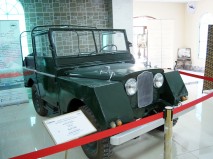1954 Land Rover Series I
Transmission - 4-speed manual
Land Rover entered production in 1948 with what was later termed the Series I. This was launched at the Amsterdam Motor Show. It was originally designed for farm and light industrial use, and had a steel box-section chassis, and an aluminum body.
n 1952 and 1953, a larger 2.0-litre petrol engine was fitted. This engine has Siamese bores, meaning that there are no water passages for cooling between the cylinders. During 1950, the unusual semi-permanent 4WD system was replaced with a more conventional setup, with drive to the front axle being taken through a simple dog clutch. Around this time the Land Rover's legal status was also clarified. As mentioned above, the Land Rover was originally classed as a commercial vehicle, meaning it was free from purchase tax. However, this also meant it was limited to a speed of 30 mph (48 km/h) on British roads. After an appeal to the Law Lords after an owner was charged with exceeding this limit, the Land Rover was classified as a "multi-purpose vehicle" which was only to be classed as a commercial vehicle if used for commercial purposes.
The 1954 model year brought major changes. The 80-inch (2,000 mm) wheelbase model was replaced by an 86-inch (2,200 mm) wheelbase model, and a 107-inch (2,700 mm) "Pick Up" version was introduced. The extra wheelbase was added behind the cab area to provide additional load space. In mid-1954 the "spread bore" petrol engine was introduced (from engines 5710xxxx), allowing better cooling between the cylinders. This had been introduced in the Rover car the year before. The engine was modified again in 1955 (from engine 1706xxxxx), sometimes known as the 'later' spread bore.






